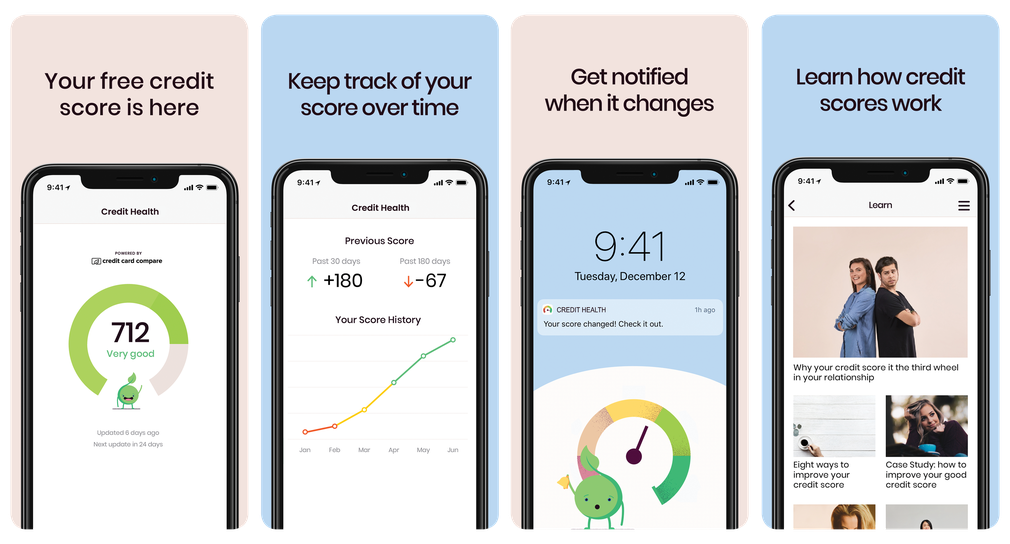
Introducing Australia’s first credit score tracking app
In an Australian-first, a credit score app has been developed to give consumers more access than ever before to their personal credit score, enabling them to monitor their credit health in real time, for free, and make proactive decisions that will improve their appeal to lenders.
The Credit Health app was created by online comparison site, Credit Card Compare, to help Australians take advantage of the changing way in which credit scores are determined, following significant reforms last year designed to reward borrowers for their positive credit behaviour.
According to Co-Founder of Credit Card Compare, Andrew Boyd, who led the development project, the process of developing the app involved drawing on established desktop functionality and then redesigning it for mobile in a way that would feel intuitive and simple for users.
“We launched our online credit score service in December 2018, so a lot of the building blocks were already in place – authenticated accounts, address lookup, the onboarding flow, and our integration with credit monitoring service Experian – however, these were developed primarily for a web browser and not a mobile device, which meant we had to develop a range of additional API endpoints.”
“Because we’re introducing a new value proposition to the audience in terms of personal credit health monitoring, we knew it was important to make the onboarding experience as easy and frictionless as possible,” Boyd says.
An important part of this related to how users entered their physical addresses. Allowing users free text entry created the potential for human error, which would prevent them being matched with their credit score, and risked losing users at the first hurdle.
“The key to solving this was using a step-by-step flow – this design decision allowed us to hide complex business logic, so the user can just get on with setting up.”
“That functionality goes to the heart of building trust and delivering on user experience expectations, so getting it right was critical. Our solution was to build our own address lookup service, using the public GNA-F dataset as the data source and Amazon Elasticsearch to filter millions of addresses in milliseconds.”
“This means users can drill down to their exact address and, because this is government data, we have a high degree of confidence that it will match what’s on file at the bureau. In the end, that means users can breeze through onboarding and get right to their score,” says Boyd.
“A good UI should make it easy to do things that are difficult. The complexity should be hidden, especially for a consumer-focused app.”
Learning a new language
Due to the development team’s limited resources – a team of just 3 people delivered the project – they chose to use Flutter, an open-source application development framework backed by Google which allowed them to write one code base and then build native apps for iOS and Android.
“When we started using Flutter, nobody in our company had any experience with Dart, which is the programming language the framework is written in,” Boyd says.
“As a result, there was a learning curve at the start of the project, which meant it took a little longer to make meaningful progress than it would have done if we had used a language such as Objective-C where we had more experience within the team.”
Flutter also brought with it another issue: risk.
“When we decided Flutter was the best fit for us, it was actually still in beta, so it had a propensity to change frequently. Native iOS design had not been totally implemented at that time, which was a problem since we planned to release our iOS app first. In the end, our solution was to write custom code for those missing pieces.”
Overcoming the acceptance barrier
“We wanted Credit Health to feel instantly familiar to users—like an app that belongs on your phone—so it uses native UI elements such as tab bars, views, and controls as recommended in Apple’s Human Interface Guidelines for iOS.”
“Much has been said about Apple’s review process for releasing an app on the App Store, but we found sticking to their review guidelines as closely as possible helped us build something we think our users will appreciate and which will naturally slot into the way they interact day to day with their phones.”
Changing the way people think about credit scores
“We know there are major changes coming to the role credit scores play in people’s financial lives in Australia, as Comprehensive Credit Reporting continues to roll out. But we also know that most Australians do not know about their credit score, let alone the role it plays in their lives.”
“We think the near future will see people actively tracking their score on their phone, and the Credit Health app allows them to make tactical decisions around how they manage their finances to maximise their results.”
“And for our business, it is the start of a move away from being almost entirely focused on acquiring more traffic, towards retaining customers and building a relationship that will help them achieve their financial goals.”
The Credit Health app is available on the App Store now, with an Android version due to be released soon.


